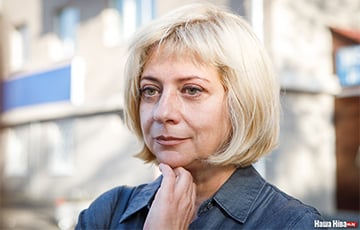The Story Of Love And Resistance
4- Iryna Khalip
- 26.04.2024, 14:26
- 14,942

PHOTO: NASHA NIVA
Repression creates heroes, not fear.
You can endlessly look not only at fire, water and Saddam Hussein on the dock. You can also endlessly look at the footage of the “Chernobyl Way-1996”.
On a day like today, in April, on the anniversary of the disaster at the Chernobyl nuclear power plant, 50 thousand people came to the center of Minsk. How these people found out about the action, I can hardly remember now. Now, years later, I, frankly, am surprised myself: how did we learn about the upcoming protests in the absence of social media or Telegram channels? It was only later, at the beginning of our century, that stickers with the date, time and place of the action began to appear, which could be seen in the elevator of one’s own entrance hall, at a bus stop, on a tram window, on a billboard in the subway, or anywhere. Young “Zubr” activists and Young Front members, ominous shadows for the security forces, dissolved in the crowd, were lost from sight, merged with the landscape — and glued and bombarded mailboxes with leaflets, and turned cities into continuous information boards. But in 1996 there were no leaflets or stickers. There was only a date: April 26, the anniversary of the Chernobyl disaster.
People gathered on Yakub Kolas Square to march along Skaryna Avenue. They were going to get to Independence Square (at that time Lukashenka had not yet managed to change not only the Constitution, but also the names of streets and squares). But after a couple of hundred meters the road to the procession was blocked by police chains and cars. The riot police went to beat the first rows of demonstrators with batons, but people began to fight back fiercely. It was scary, there were bloody clothes and bandaged heads, there was a desire to turn around and run, but instead the march participants began to overturn police cars and break through the chain of security forces. And they broke through. And they moved on, while simultaneously providing assistance to the victims. And we reached the circus.
An already armed special forces cordon was waiting at the circus, and people turned onto Yanka Kupala Street. We reached the Sports Palace and held a rally there. “The city is ours!” — this is one of the slogans that sounded then. And it was filled not only with conviction, but also with righteousness: yes, we marched, we turned from one avenue to another, we were in the city center, we held a rally where we said everything we wanted. I remember the embossed profile of Zianon Pazniak, I remember General Yury Zakharanka, I remember officers and poets, young people and pensioners, deputies and scientists. And the general belief that one little effort more will make this uneducated caricature of the government collapse.
After the “Chernobyl Way”, political prisoners appeared in Belarus. Opposition leaders Yury Khadyka and Viachaslau Siuchyk were arrested, as well as Ukrainians from the UNA-UNSO, who purposefully came to Minsk to participate in the “Chernobyl Way”. For some reason they were held in the Akrestsin street detention center, although Khadyka and Siuchyk were immediately sent to the pre-trial detention center on Valadarski street. The information that the Ukrainians were in the Akrestsin street detention center was discovered in a very simple way: they managed to pass a note “to the outside world.” They asked a cellmate who was to be released after an administrative arrest to give someone a piece of paper on which they wrote where they were. The cellmate took the note and threw it into the courtyard of a private house nearby. And then the owner of the house found it and brought it to the editorial office of the newspaper “Imya”.
The Ukrainians were released by diplomats, and Yury Khadyka and Viachaslau Siuchyk went on a hunger strike. And they were on hunger strike for three weeks. Three weeks later it became known that Siuchyk’s kidneys were failing. And Lukashenka broke down. Both prisoners were taken to a civilian hospital, and Viachaslau Siuchyk was taken to intensive care, and then the restraint was changed.
And after some time, the criminal case was quietly closed. By the way, after that very “Chernobyl Way” the Viasna human rights center was born, which was first called “Viasna-96”. And if not for the first repressions in Belarus, there would be no trace of “Viasna”. Ales Bialiatski would not have become a Nobel laureate, famous throughout the world, and would have continued to quietly carry out his research in the museum. If Lukashenka had been smarter, he would have realized even then that repression gives rise to heroes, not fear.
Today I remember “Chernobyl Way-96” not only because it’s April 26 and the anniversary of the disaster again: the heroes need to be remembered regularly, and not just in connection with dates. I just sometimes hear stupid things like “in 2020, Belarusians became a nation” and I hasten to remind those who have been sleeping under the bench for years: Belarusians have always protested. In the last century, and in the century before last. Our history is a story of revolt, uprising, resistance. The story of finding our land, which they are trying to take away from us again. The story of heroes whose existence justifies our defeats. The story of love.
Iryna Khalip, exclusively for Charter97.org









